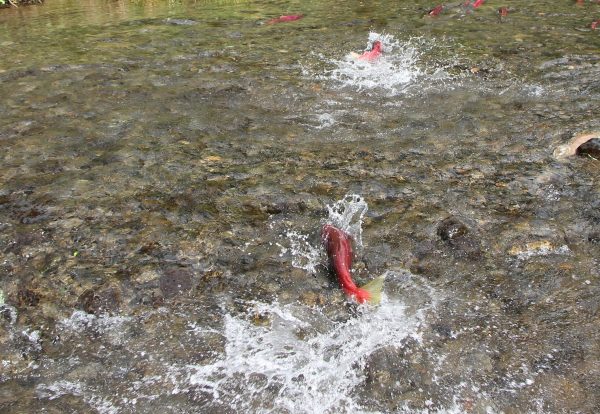
Almost 49 million sockeye are forecast to return to Bristol Bay this summer.
“It’s looking pretty good — this is a relatively high forecast,” said Greg Buck, the area research biologist for the Alaska Department of Fish and Game.
If ADF&G’s forecast of 48.9 million sockeye is correct, the run would be 6% larger than the average over the past decade. It would be almost 30% larger than the long-term average of 34.6 million.
That’s significant. While Bristol Bay’s runs have fluctuated greatly over the years, the past few summers have seen enormous returns. At 62.3 million fish, 2018 broke the record for the bay’s largest run ever recorded.
Buck said that if the runs continue at this pace, fish could start to produce fewer offspring in systems like the Wood River, on the west side of the bay.
“We’ve had kind of record returns somewhere in the bay for several years now,” he said. “Typically what you’d expect is that at low levels of return, you’d get very productive spawner recruits. Each fish will produce many more than itself. The thinking is, at the higher end you don’t get that, because of resource competition of smolts, carrying capacity of the lakes, that kind of thing. So we may test the upper bounds of the system in a couple years. I don’t know.”
Based on the forecast, fishermen could haul in up to 36.9 million fish in 2020. The average harvest over the past 10 years is 31 million. According to the Bristol Bay Regional Seafood Development Association, the fishery generates $658 million in labor income on average, and is valued at around $1.2 billion.
“These last two or three years have been some of my best years, catch-wise and certainly dollar-wise, too” said Mark Niver, who has fished in Bristol Bay for forty years. “It’s just nice to see a steady pattern of fish coming back. Cause usually it’s kind of a roller coaster — there’ll be some good years and some bad years. And we’ve had a good string of good years.”
Half of Bristol Bay’s ten largest runs on record have returned in the last five years. Niver acknowledged that it can’t stay this strong forever, but, at least in the short-term, he’s optimistic.
ADF&G expects next year’s Naknek-Kvichak run to be bigger than in 2019, with 20 million reds in the forecast. Ugashik’s run would be up from last summer as well, at 4.6 million. The rest of the bay would be down from 2019: the Nushagak District’s run is forecast at 12.6 million reds, Egegik’s run is set at 10.7 million, and Togiak’s run is at 9.3 million.
One major uncertainty is Egegik, a district on the east side of the bay. In 2019 it exceeded its forecast by nine million reds. And one cohort stood out in particular: A record number of fish in the run had spent one year in freshwater and two years in the ocean. The unexpected influx from that 1-2 age class made 2020 especially difficult to forecast.
Biologists count fish in each age class to predict how many of their siblings will return the following year.
“This year we had to run the reconstruction model, like, three times to get Egegik to fit,” Buck said. “We had to use a hammer to get that sucker to go in. So forecasting off of that brood table is definitely a question mark.”
To forecast the run, researchers compare how many younger fish are caught to those that escaped to the spawning grounds. That data, along with genetic analysis, helps predict how many older fish from the same age class will return in future seasons. Overall, 1-3 fish are expected to be the largest age class in 2020, making up 43% of the run. One-twos are a close second, followed by 2-2s and 2-3s.
Last summer also saw an unusually high number of fish that spent only one year in freshwater and one in the ocean. Those are called “jacks.” Daniel Schindler is a professor at the University of Washington who researches Pacific salmon in southwest Alaska. He explained that generally, only 1% of the returning reds are jacks.
“This year, for most of the streams here in the Wood River, we’re seeing between 5 – 10% of the males are jacks,” he said, speaking on the shore of Lake Nerka at the beginning of September,
While Schindler said he can’t know for certain what that means, it does give some clues as to what the run will look like in 2020.
“Typically what a big return of jacks reflects is high survival rates for the smolts when they left for the ocean a year ago,” he explained. “And what that typically translates into is a big return of fish that spent two years in the ocean next year, and possibly a lot of fish that spent three years in the ocean, two years from now. So in many ways it’s a leading indicator of what we should expect for older fish next year.”
These are only a few of the factors that shape the sockeye runs in Bristol Bay, and forecasting is inherently difficult. ADF&G notes that next summer’s run could drop to 36.4 million or exceed 61 million fish.
Reporting was made possible in part by the Institute for Journalism & Natural Resources.




